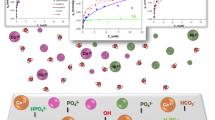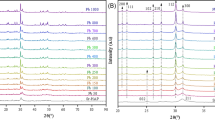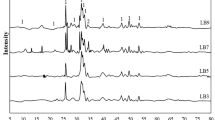Abstract
Calcium hydroxyapatite (Ca-HAp) was synthesized from calcium carbonate (CaCO3) extracted from a paper mill sludge. The extraction of CaCO3 was carried out by chemical precipitation process and synthesized to HAp nanoparticle under appropriate stoichiometric condition through wet chemical precipitation process. The size of the HAp nanoparticle was 42.5 nm under an optimized aging period of 24 h. This work aims in the batch adsorption of arsenic, an anionic metal arsenic in the form of Arsenite: As(III) on the synthesized Ca-HAp in laboratory scale. Batch kinetics studies were conducted for varying operational parameters such as temperature, initial adsorbate concentration, dye solution pH and rotation speed (RPM). In comparison with the two suggested isotherm models, Langmuir isotherm was suited to this adsorption process with a correlation coefficient of 0.92 and isotherm constant as 1.18 (KL). Chemisorption was found to be the rate-limiting mechanism for the sorption of arsenite onto Ca-HAp and thus followed pseudo-second-order kinetics. A maximum monolayer adsorption of 0.43 mg/g of arsenic was obtained at an equilibrium time of 60 min with 93% to 94.2% removal efficiency.
Similar content being viewed by others
Introduction
The persistent arsenic contamination in natural water bodies and ground water streams is one of the major threat and challenge faced by the human community throughout the world. Most of the Gangetic and Brahmaputra basins flowing along the northeastern parts of the country had been reported with higher arsenic contamination, thereby exceeding the permissible drinking water limits (50 µg/L). Arsenic occurs in soils and water due to natural activities like weathering of rocks, volcanic eruption and due to anthropogenic activities. Natural existence of arsenic occurs in four oxidation states as As3−, As, As3+ and As5+. Among them, inorganic Arsenate: As(V) and Arsenite: As(III) are the most abundant forms present in natural waters. Highly toxic forms of As(III) are more prevalent under reduced and water-logged conditions than As(V). Epidemiological studies had demonstrated retard mental development, cancer and other organ failures due to the presence of arsenic in drinking water for a prolonged period.
Earlier research investigations have resulted in the effective removal of arsenic using HAp from contaminated drinking water sources (Mahsa et al. 2014 and Nakahira et al. 2006). Various treatment processes and technologies such as coagulation and ion-exchange process (Hesami et al. 2013; Wickramasinghe et al. 2004), adsorption on activated alumina and oxides/hydroxides of iron, calcium and phosphate (George et al. 2018; Lescano et al. 2015 and Cakmakci et al. 2009) are adopted for the elimination of arsenic from water. Some studies have been done using HAp bovine powder and HAp modified with SiO2 as adsorbent in removing arsenic from geothermal hot water (Nakahira et al. 2006). Biological treatment process and membrane filtration have also shown good results in arsenic removal (Harfoush et al 2018 and Katsoyiannis et al. 2004). Despite the existence of various arsenic treatments, adsorption is preferred as the most appropriate technique due to its cost-effective and operation difficulties. The ion exchange property of calcium hydroxyapatite in substituting arsenic ions for phosphate and calcium groups has attracted the researchers to use it as an adsorbent for arsenic removal (Wang et al. 2021; Hokkanen et al. 2019; Liu et al. 2017; Yoon et al. 2017; Dungkaew et al. 2012).
Due to its biocompatible, bioactive and osteo-conductive nature, Ca-HAp is extensively used in biomedical field (Sharanabasava et al. 2016). Some researchers have reported that hydroxyapatite acts as an efficient adsorbent because of its structural stability and long-term containment of contaminants. The P–OH functional group present in the Ca-HAp acts as the active sorption sites (Mobasherpour et al. 2012) and hence been utilized as a stabilizing agent in various heavy metal removals such as Cr, Co, Cu, Ni, As, and Zn. The previous studies have used chemically, hydrothermally and biologically synthesized HAp from natural resources and ceramics. The synthesis of HAp from unused waste resource like paper mill sludge is not presently explored. In the present work, calcium hydroxyapatite obtained from paper sludge was chosen as a sorbent to remove the anionic heavy metal arsenic As (III)). Studies have also been focused in the adsorption process and mechanism due to the influence of kinetic operational parameters.
Material and methods
Materials and methodology
The synthesis of hydroxyapatite was carried using paper mill sludge. The collected sludge was air dried and used for further experimental investigations. Analytical grade chemicals and distilled water were used in preparing solutions throughout the experimental study investigations. The oven-dried paper sludge is converted into ash pyrolyzed at 800 °C. The calcium carbonate is extracted from the paper sludge ash by chemical precipitation method (Bloomquist and Betz 2001). Arsenic standard solutions were prepared by dissolving arsenic trioxide in distilled water in appropriate volume ratio for the required concentrations.
Preparation of hydroxyapatite
The HAp was synthesized by adding certain amount of orthophosphoric acid to Ca(OH)2 powder (Dan Nicolae Ungureanu et al. 2011). Intense stirring with dropwise addition of orthophosphoric acid over the alkaline solution of Ca(OH)2 was carried over to obtain hydroxyapatite in slurry form. The pH and temperature during the synthesizing process were maintained at 8.5 and 40–45 °C, respectively. Due to continuously stirring, the solution turns into milky white, and then, it is kept for an aging of 24 h.
Batch sorption studies
The kinetic adsorption studies of hydroxyapatite were conducted under varying parameter conditions like pH, arsenite concentration, temperature and mixing speed. In batch mode, adsorption studies were performed at varying pH (4.0,7.0 and 9.0), agitation speed (100 rpm,120 rpm and 140 rpm), initial arsenic concentration (0.1–0.5 mg/L), temperature (20–50 °C) at a constant dosage of 0.5 g. Duplicate trials were conducted for each experimental run for accuracy. The arsenic concentration was determined using arsenic test kit.
Results and discussion
Batch adsorption studies
Equilibrium time
The sorption of As(III) on the HAp adsorbent was studied under varying initial arsenic concentration. The initial arsenic concentration considered under this study was varied from 0.1 to 0.5 mg/L. The pH was maintained at neutral (i.e.,7.0) for temperature 30 °C at a rotating speed of 120 rpm. The arsenic removal was studied at frequent intervals of time period such as 30 min to 90 min and reached an equilibrium at 60 min (Fig. 1). The further studies were conducted at this equilibrium time, because no further prominent change in adsorption was identified beyond the equilibrium time.
Effect of pH
The affinity of arsenic adsorption toward the binding sites of Ca- Hap is highly influenced by the solution pH. The behavior of As(III) on HAp at different pH such as 4, 7 and 9 is shown in Fig. 2. It was observed that arsenic uptake by the adsorbent increased with higher pH. The highest adsorbent capacity (0.0582 mg/g) of As(III) ions was found at pH 9 with 94.2% removal efficiency.
The influence of pH under strongly acidic pH causes dissolution of sorbent which leads to low adsorption process. The As (III) is stable at acidic pH, thereby causing weak force of attraction between sorbent and sorbate sites. The positively charged adsorption sites of HAp enabled the removal of anionic arsenic metal sites at higher pH 9.0 due to increase in intermolecular attraction of the heavy metal ions to get trapped in the calcium and phosphate ion sites (Liu et al. 2010).
Effect of Initial sorbate concentration
Effect of initial As (III) concentration was investigated at initial concentrations between 0.1 and 0.5 mg/L at the equilibrium time of 60 min and is shown in Fig. 3. The driving force was greater at higher arsenite concentration leading to the transfer of arsenite ions from aqueous bulk solution to the Ca-HAp surface (Iqbal et al. 2019). A maximum removal efficiency was observed between 93 and 94.2% of arsenite was obtained for concentrations between 0.1 and 0.5 mg/L, respectively, and is represented in Fig. 4.
Isothermal studies
The analysis of experimental data to fit the appropriate isotherm models is an important phenomenon to understand an adsorption system. In this work, Langmuir and Freundlich isotherm models were adopted to study the adsorption behavior of arsenic onto Ca-HAp,
Langmuir model
In the Langmuir isotherm model, the containment of arsenic onto the adsorption site is due to the uniform monolayer surface contact with no reincarnation of As (III) in the plane surface. The Langmuir isotherm is represented as indicated in Eq. 1.
where Ce = equilibrium concentration in the solution, mg/L, qe = amount adsorbed on the adsorbent at equilibrium, mg/g, qo = maximum adsorption capacity, mg/g, KL = Langmuir adsorption constant, L/mg related to the affinity of the binding sites. A maximum adsorption capacity of 0.43 mg/g for a constant of 1.18 was calculated from the isothermal plots of Fig. 5. The value of KL > 1 implies a greater affinity of the arsenite is toward the adsorbent revealing extremely good applicability in this adsorptions process.
Freundlich model
The heterogeneous surface adsorption on multilayer is represented by the Freundlich isotherm model. The Freundlich Isotherm is represented by empirical formula as in Eq. 2
where Ce = Equilibrium concentration in the solution, mg/L, qe = Amount adsorbed on the adsorbent at equilibrium, mg/g, Kf = Adsorption capacity, mg/g and n = Adsorption intensity parameter. The calculated Freundlich constants 1/n and Kf from Fig. 6 were 0.32 and 0.08 mg/g, respectively, with a correlation coefficient of 0.86. The 1/n values found between 0.1 < 1/n < 1 showed good adsorption ability of HAp. The behavior of adsorption followed both the models with satisfactory constant values. The Langmuir isotherm yielded better fit witKL > 1 and R2 as 0.92 compared with lesser R2 value of 0.86. Therefore, the adsorption of arsenite ions under considerations was linear and best fitted in Langmuir isotherm plot.
Pseudo-first-order reaction kinetics
Pseudo-first-order equation is given as in Eq. 3.
where qt = Amount of As(III) ions removed at time t, mg, qe = adsorption capacity at equilibrium, mg/g, k1 = pseudo-first-order rate constant, 1/min, and t = contact time, min. Using the qe and constant k1 values obtained from Fig. 7 were 0.020 mg/g and 0.037 min−1, respectively.
Pseudo-second-order reaction kinetics
Chemisorption is the rate limiting step of a pseudo-second-order kinetics the linear form of this model is expressed as in Eq. 4.
where qe = Adsorption capacity at equilibrium, mg/g, k2 = pseudo-second-order rate constant, (g/mg/min). The calculated values of qe and k2 are 0.06 mg/g and 6.47 (g/mg/min) are determined from Fig. 8, using Eq. 4.
The estimated correlation coefficient estimated from pseudo-first-order kinetics was 0.95, and the kinetic data were insufficient to determine the calculated qe and the experiment qe values. The resistance caused by the boundary layer due to the time lagging during start of the sorption process (Vijayaraghavan et al. 2007) shows the change in qe determination. The higher R2 value (0.99) and adsorption capacity (0.06 mg/g) derived from pseudo-second-order plot confirmed the adsorption mechanism of arsenite onto nano-synthesized Ca-HAp is controlled by chemisorption process (Yao et al. 2014).
Conclusion
The Ca-HAp synthesized from paper sludge showed effective arsenic removal efficiency of about 94.2% at an equilibrium time of 60 min under an alkaline pH (9.0). For an increase in initial arsenic metal concentration from 0.1 to 0.5 mg/L, an increase in adsorption capacity by 0.02 mg/g is observed. The Langmuir isothermal plots showed best-fitted plots with higher R2 value of 0.92 and isotherm constant (KL) as 1.18, respectively. The determined monolayer adsorption capacity of arsenic onto CA-HAp was 0.43 mg/g. Pseudo-second-order kinetics with correlation coefficient (0.99) confirmed chemisorption between the adsorbent and adsorbate with higher molecular interaction due to the nanoparticle size of HAp. Therefore, calcium phosphate hydroxyapatite synthesized from paper mill sludge showed potential adsorption capability in the removal of synthetic As (III) ions in aqueous solution.
References
Bloomquist M, Betz G (2001) Method of recovering calcium from waste material or contaminated natural calcic material. Patent no: US6193945B1
Cakmakci M, Baspinar A, Balaban U, Uyak V, Koyuncu I, Kinaci C (2009) Comparison of nanofiltration and adsorption techniques to remove arsenic from drinking water. Desalin Water Treat 9(1–3):149–154
Dungkaew W, Haller KJ, Flood AE, Scamehorn JF (2012) Arsenic removal by precipitation with calcium phosphate hydroxyapatite. Adv Mater Res 506:413–416
Ganachari SV, Bevinakatti AA, Yaradoddi JS, Banapurmath NR, Hunashyal AM, Shettar AS (2016) Rapid synthesis, characterization, and studies of hydroxyapatite nanoparticles. Adv Mater Sci Res 1(1):9–13
George S, Mehta D, Saharan VK (2018) Application of hydroxyapatite and its modified forms as adsorbents for water defluoridation: an insight into process synthesis. Rev Chem Eng 36(3):369–400
Harfoush M, Mirbagheri SA, Ehteshami M, Nejati S (2018) Arsenic removal from drinking water using low-pressure nanofiltration under various operating conditions. Water Pract Technol 13(2):295–302
Hesami F, Bina B, Ebrahimi A, Amin MM (2013) Arsenic removal by coagulation using ferric chloride and chitosan from water. Int J Env Health Eng. https://doi.org/10.4103/2277-9183.110170
Hokkanen S, Doshi B, Srivastava V, Puro L, Koivula R (2019) Arsenic (III) removal from water by hydroxyapatite-bentonite clay-nanocrystalline cellulose. Am Instit Chem Eng. https://doi.org/10.1002/ep.13147
Iqbal J, Shah NS, Sayed M, Imran M, Muhammad N, Howari FM, Alkhoori SA, Khan JA, Khan ZUH, Bhatnagar A, Polychronopoulou K, Ismail I, Haija MA (2019) Synergistic effects of activated carbon and nano-zerovalent copper on the performance of hydroxyapatite-alginate beads for the removal of As3 from aqueous solution. J Clean Prod 235:875–886
Katsoyiannis IA, Zouboulis AI (2004) Application of biological processes for the removal of arsenic from groundwaters. Water Res 38(1):17–26
Lescano MR, Passalía C, Zalazar CS, Brandi RJ (2015) Arsenic sorption onto titanium dioxide, granular ferric hydroxide and activated alumina: batch and dynamic studies. J Environ Sci Health 50(4):424–431
Liu G, Talley JW, Na C, Larson SL, Wolfe LG (2010) Copper Doping improves hydroxyapatite sorption for arsenate in simulated ground waters. Environ Sci Technol 44(4):1366–1372
Liu W, Mei Y, Etschmann B, Brugger J, Pearce M, Ryan CG, Borg S, Wykes J, Kappen P, Paterson D, Boesenberg U, Garrevoet J, Moorhead G, Falkenberg G (2017) Arsenic in hydrothermal apatite: oxidation state, mechanism of uptake, and comparison between experiments and nature. Geochim Cosmochim Acta 196:144–159
Mahsa M, Biazar E, Saeb K (2014) Removal of arsenic from drinking water by hydroxyapatite nano particles. Curr World Environ 9(2):331. https://doi.org/10.12944/CWE.9.2.13
Mobasherpour I, Salahi E, Pazouki M (2012) Comparative of the removal of Pb2+, Cd2+ and Ni2+ by nano crystallite hydroxyapatite from aqueous solutions: adsorption isotherm study. Arab J Chem 5(4):439–446
Nakahira A, Okajima T, Honma T, Yoshioka S, Tanaka I (2006) Arsenic removal by hydroxyapatite-based ceramics. Chem Lett 35(8):856–857
Ungureanu DN, Angelescu NICOLAE, Ion RM, Stoian EV, Rizescu CZ (2011) Synthesis and characterization of hydroxyapatite nanopowders by chemical precipitation. Isbn: 978-960-474-276-9.
Vijayaraghavan K, Yeoung SY (2007) Utilization of fermentation waste (Corynebacterium glutamicum) for biosorption of Reactive Black 5 from aqueous solution. J Hazard Mater 141(1):45–52
Wang Z, Miao R, Ning P, He L, Guan Q (2021) From wastes to functions: a paper mill sludge-based calcium-containing porous biochar adsorbent for phosphorus removal. J Colloid Interface Sci 593:434–446
Wickramasinghe SR, Han B, Zimbron J, Shen Z, Karim MN (2004) Arsenic removal by coagulation and filtration: comparison of groundwaters from the United States and Bangladesh. Desalination 169:224–231
Yao S, Liu Z, Shi Z (2014) Arsenic removal from aqueous solutions by adsorption onto iron oxide/activated carbon magnetic composite. J Environ Health Sci Eng 12(1):58
Yoon K, Cho DW, Tsang DC, Bolan N, Rinklebe J, Song H (2017) Fabrication of engineered biochar from paper mill sludge and its application into removal of arsenic and cadmium in acidic water. Biores Technol 246:69–75
Funding
This research work had not been funded by any Government or Quasi Government funding agencies.
Author information
Authors and Affiliations
Contributions
The authors of the submitted manuscript take the sole responsibility in carrying out the above work in the institution laboratory and is dependent on the scope of the journal.
Corresponding author
Ethics declarations
Conflict of interest
The prepared manuscript for possible publication in this journal is submitted by the authors mentioned. The authors have no affiliation with any organization with a direct or indirect financial interest in the subject matter discussed in the manuscript.
Ethical approval
Authors confirm that appropriate ethics were adopted during the period of experimentations and documentation.
Human and animal research
No research involving human or animals were involved.
Additional information
Publisher's Note
Springer Nature remains neutral with regard to jurisdictional claims in published maps and institutional affiliations.
Rights and permissions
Open Access This article is licensed under a Creative Commons Attribution 4.0 International License, which permits use, sharing, adaptation, distribution and reproduction in any medium or format, as long as you give appropriate credit to the original author(s) and the source, provide a link to the Creative Commons licence, and indicate if changes were made. The images or other third party material in this article are included in the article's Creative Commons licence, unless indicated otherwise in a credit line to the material. If material is not included in the article's Creative Commons licence and your intended use is not permitted by statutory regulation or exceeds the permitted use, you will need to obtain permission directly from the copyright holder. To view a copy of this licence, visit http://creativecommons.org/licenses/by/4.0/.
About this article
Cite this article
Keerthana Devi, P., Geethakarthi, A. Arsenic removal using calcium hydroxyapatite synthesized from paper mill sludge. Appl Water Sci 12, 174 (2022). https://doi.org/10.1007/s13201-022-01694-4
Received:
Accepted:
Published:
DOI: https://doi.org/10.1007/s13201-022-01694-4












